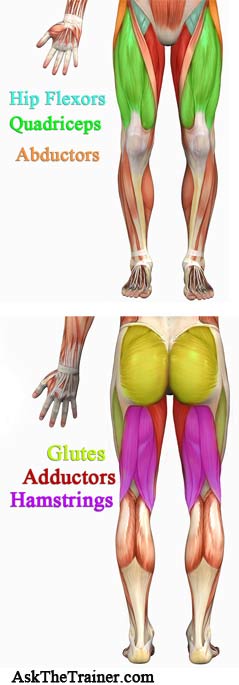
It is Not as Simple as just Quads and Hamstrings
Leg muscle anatomy may seem straight forward when you look at a simple anatomy chart but is more complex.Some muscles or parts of the muscles in the legs are responsible for multiple actions and act on both the hip and knee joints.
Quadriceps
The quadriceps or "quads" is one of the largest muscles in your body. Many of the best leg exercises focus on the quads. The primary function of the quadriceps is leg extension. Leg extension is the motion of extending your knee like kicking a ball.
Hamstrings
The hamstrings flex (curl) your leg. If you were standing and lifted your heel back to try to touch your butt your hamstrings would perform the action.
Glutes
There are 3 gluteal muscles. You have heard of the gluteus maximus which is the largest muscle in your body. There is also the gluteus minimus and medius. The group is often referred to as the glutes.
The primary function of the glutes is to extend your hip but they have many other functions such as leg abduction which is moving your leg away from your body to the side.
Hip Flexors
The hip flexors are the muscles which lift your knee up as if you were about to march. The hip flexors are a chronic tight muscle which causes posture problems.
Adductors
The adductor complex is the group of muscles of your inner thigh. The primary function of the adductors is to adduct your legs. Adduction is the moving of moving your legs together from away from your body.
Abductors
Abduction is the motion of moving a leg to the side away from your body. You may have heard your abductors referred to as your outer thighs.
To Avoid Knee Injury it is Helpful to Learn the Basic Structure of the Knee Joint
The Knee Actually Consists of 3 different Articulations or Joints
It is important you know the difference between the 3 articulations to avoid injury while your perform the best leg exercises. The first joint is the tibiofibular joint. It connects the tibia and fibula, the lower leg bones. It is an arthroidial joint which means it allows very little motion. You do not have to worry about injuring your tibiofemoral joint
The 2 Joints You Should be Familiar with in the Knee
Tibiofemoral JointThe tibiofemoral joint is the articulation of the largest bone in your body, the femur (upper leg bone) and the tibia (larger of the 2 lower leg bones.)
The Tibiofemoral Joint is Supported by 4 Ligaments
You may have heard many times about injuries to the knee ligaments specifically the ACL (Anterior Cruciate Ligament) and MCL (Medial Collateral Ligament.) The tibiofemoral joint is also supported by the 3rd joint involved in the knee the patellofemoral joint.ACL and MCL sprains and tears are common sports injuries.
This may be misleading because most of the injuries are due to trauma which is one specific event. The tibiofemoral joint is less likely to have problems related to weight training or cardio exercise.
Patellofemoral Joint

The patellofemoral joint is the articulation of the patella (kneecap) and the femur.
The Patellofemoral Joint is Prone to Chronic Injuries
Chronic injuries are overuse injuries. Overuse injuries happen over time and are associated with a specific repetitive motion. This constant overload will eventually cause an injury.Common chronic injuries of the patellofemoral joint are runner's knee and jumper's knee.
Runners Knee is the name given for chondromalacia patellae which is the degeneration of the back of the kneecap.
Jumper's knee is patellar tendonitis which is inflammation of the patellar ligament which is often referred to as a tendon.
Patellofemoral joint problems are frustrating to most active people because they take a long time to heal with complete rest.
Overuse injuries can be exacerbated by muscle imbalances, posture problems, and poor exercise form. Be very cautious while you perform the best leg exercises. If you ever experience knee pain, you may need to take a step back.
How are Problems and Injuries with the Knees Avoided ?
Since Exercise in the Gym Consists of Repetitive Motions; Protecting the Patellofemoral Joint is a Must
This means proper form is necessary at all times when you perform the best leg exercises. The easiest way to minimize stress on the patellofemoral joint is to be aware of the relationship of your knees to your toes during the best leg exercises.Specifically, your center of gravity should not travel forward while your patellofemoral joint is bearing a load. This simply means keep your hips from traveling forward while your knees are bearing a load.
You can avoid potential patellofemoral problems by using proper form. If you have posture problems which make it extremely difficult or impossible to maintain proper form you may want to visit a physical therapist or personal trainer who can diagnose and run you through a corrective stretching program to correct the muscle muscle imbalances which cause the posture problems.
No comments:
Post a Comment